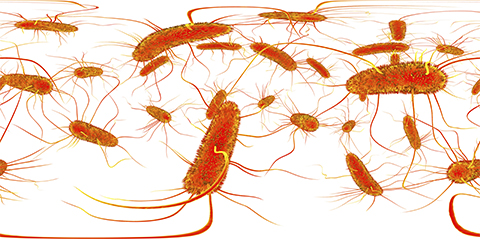How Salmonella runs hot and cold
“Don’t eat raw cookie dough!” is something adults often say to children. One reason we wash vegetables, cook meat and — usually — don’t eat raw cookie dough is to avoid getting infected with pathogens like Salmonella.
As familiar as the name of this bacteria is, there’s quite a bit we don’t know about how it grows and spreads. One thing complicating our understanding is that Salmonella survives in disparate conditions. We have a handle on its life when it gets into our bodies, but it also must survive on crops in cooler outdoor temperatures and even in the fridge.

Researchers in Osnabrück, Germany, recently published a study in the journal Molecular & Cellular Proteomics about how the Salmonella proteome changes under different temperatures and nutrient conditions, opening the door to developing more efficient prevention techniques.
To understand how Salmonella survives, they grew it at temperatures from about as cold as a refrigerator up to as warm as a human body. They also varied the available nutrients. Then, after monitoring growth rate and other factors, they collected samples from all the growth conditions, extracted the proteins and analyzed them by mass spectrometry to get a picture of each one’s entire proteome.
They found tons of data, which they’ve made available for other researchers, and started characterizing it with broad strokes. More pathogenic factors were expressed at body temperature. Heat and cold stress response proteins changed across the conditions, as did proteins regulating gene expression and metabolism: Glycolysis enzymes are less abundant at colder temperatures, so the Salmonella may be upregulating their citric acid cycle to compensate.
When looking at the proteomic data for the cooler temperatures, they made unexpected finds, according to first author Laura Elpers. “It was a surprise to identify flagella,” the long thin structures bacteria use like a propeller for locomotion, she said.
In E. coli, another common foodborne pathogen, flagella are expressed only at body temperature, not colder temperatures, and researchers thought it would be the same for Salmonella. “At first I thought, ‘that cannot be,”’ Elpers said. “I thought the proteomics was messed up, so we checked them.”
Elpers stained her cells grown in cooler temperatures for flagella proteins and looked under a 100x microscope. “I was quite excited when I did the staining and could see the flagella,” she said.
The team plans to look further into the flagella — it appears that they may be structured differently at cooler temperatures than at body temperature and may move differently. At body temperature, the team could see the Salmonella swimming around quickly, while at cooler temperatures the bacteria creep and crawl slowly.
“What is the flagella doing at the lower temperature?” asked Michael Hensel, the lead author. “The temperature is similar to conditions in agriculture — prior to climate change. It’s a bacterial pathogen that hasn’t been considered to be motile at that temp. But it may actually be able to reach new hosts and spread.”
Enjoy reading ASBMB Today?
Become a member to receive the print edition four times a year and the digital edition monthly.
Learn moreGet the latest from ASBMB Today
Enter your email address, and we’ll send you a weekly email with recent articles, interviews and more.
Latest in Science
Science highlights or most popular articles

Exploring the link between lipids and longevity
Meng Wang will present her work on metabolism and aging at the ASBMB Annual Meeting, March 7-10, just outside of Washington, D.C.

Defining a ‘crucial gatekeeper’ of lipid metabolism
George Carman receives the Herbert Tabor Research Award at the ASBMB Annual Meeting, March 7–10, just outside of Washington, D.C.

The science of staying strong
Muscles power every movement, but they also tell the story of aging itself. Scientists are uncovering how strength fades, why some species resist it and what lifestyle and molecular clues could help preserve muscle health for life.

Bacteriophage protein could make queso fresco safer
Researchers characterized the structure and function of PlyP100, a bacteriophage protein that shows promise as a food-safe antimicrobial for preventing Listeria monocytogenes growth in fresh cheeses.

Building the blueprint to block HIV
Wesley Sundquist will present his work on the HIV capsid and revolutionary drug, Lenacapavir, at the ASBMB Annual Meeting, March 7–10, in Maryland.

Gut microbes hijack cancer pathway in high-fat diets
Researchers at the Feinstein Institutes for Medical Research found that a high-fat diet increases ammonia-producing bacteria in the gut microbiome of mice, which in turn disrupts TGF-β signaling and promotes colorectal cancer.

